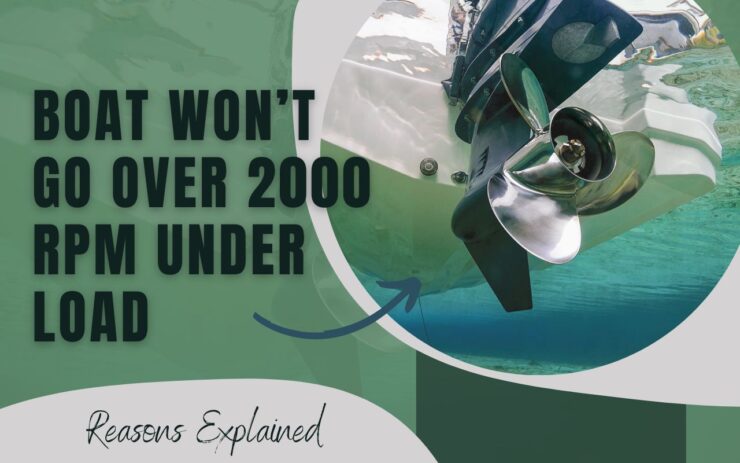An engine with a range of 5000-5800 RPM (as noted on the boat tachometer) will achieve 5400 rpm with the boat operating wide open and trimmed out for best performance. But sometimes it can occur that it won’t go over 2000rpm.
So, why won’t your boat go over 2000 rpm under load?
There may be a few causes for why your boat won’t rev higher than 2000rpm. It can be because of a badly chosen prop, debris on the propeller, or bad fuel. Poor cylinder condition or damaged carburetor can also cause this. You need to troubleshoot the boat engine to get the desired rpm.
This article will explain why your boat may not be working at maximum power.
Aside from that, we also explore what can be causing acceleration hesitation. So let’s begin without any further ado.
Table of Contents
ToggleWhy Isn’t Your Outboard Engine Performing at 2000 RPM?
So what is the perfect speed for your boat? Your boat may not run properly over 2000 rpm under load. It is a common disorder that can happen for a number of different reasons.
The most likely causes are as follows:
- The rotating propeller
- Entangled debris on a boat propeller
- Air leak in the fuel line
- Spark plug wiring that has corroded
What Causes Outboard Motor Power Loss?
Nothing is more infuriating than your engine failing to function at its peak, even at full blast. This situation is the quickest way to destroy what could have been a great day.
A Spinning Propeller
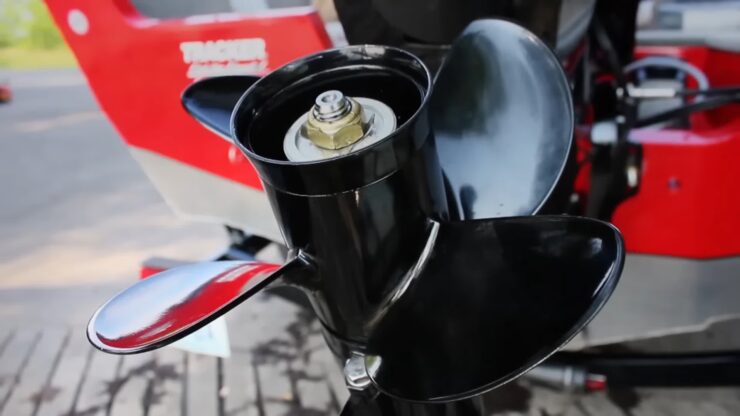
One of the reasons your powerboat may struggle to reach adequate speed is a twisted prop. This happens when the connection between your boat’s propeller and the prop shaft is damaged. This damage causes the rubber inserts to start rotating independently.
- Every inch of propeller radius reduces RPM by around 500.
- RPM is reduced by around 150-200 for every increased inch of blade pitch.
A spun prop can lead your outboard engine to run out of power and your boat to decrease top speed. Take your outboard motor to a nearby marine mechanic for repair if you feel that. There is a difference between stainless steel and aluminum prop rpm.
A quick safety warning: even if your boat appears to be going normally, functioning with a spun prop risks severely destroying your propeller. Or else you will be left with a malfunctioning boat which is not a good scenario.
Debris Interfering with Your Propeller
Have you remembered checking the propeller on your boat for debris? If your boat is having trouble achieving full speed, it may be necessary to perform an inspection. Seaweed, rope, fishing gear, and other materials frequently clog the propeller blades.
This entanglement can limit the natural movement of your blade. By removing this debris, you may be able to enable your blades to spin freely, resolving the problem of the outboard motor failing to run at full power.
Actually, you should inspect your propeller on a frequent basis—at least every few outings, if not every outing. Keeping your propeller clear of entanglements will undoubtedly aid in maintaining top-outboard engine performance and avoiding engine damage.
Prop Assembly Damage
A damaged propeller is a major issue since it prevents your engine from running efficiently. Fortunately, it is not difficult to discover and correct.
To troubleshoot your propeller, follow these steps:
Remove the boat from the water and inspect the propeller blades. The blades should not be fractured, chipped, twisted, or otherwise damaged. Examine the blades carefully to ascertain their condition.
The blades should still be measured despite the lack of apparent damage to them. If the prop blades are not the same size, they are damaged (most likely bent).
Examine the propeller shaft on your boat. A bent shaft will oscillate, preventing the motor from reaching maximum RPM. A bent shaft should also be detectable by looking at the prop assembly from the side.
Furthermore, the hubs of your propeller may have been destroyed. Hubs deteriorate with usage, so if you have a ten-year-old prop, this is most likely what you’re dealing with.
If you discover that your prop is broken, you should simply replace it. If somehow the propeller blades or shaft are bent, you can try to straighten them out, but you won’t be able to do it precisely.
Badly Chosen Prop
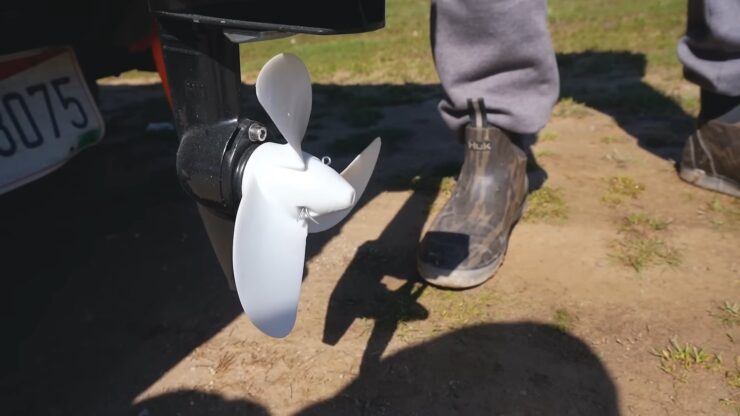
In most cases where you are getting low RPM, a badly chosen prop will not be the cause. However, if you have a new boat, it’s possible that you’ve chosen components badly.
Here’s how RPM changes with propeller specs:
- Every additional inch in propeller diameter reduces RPM by about 500.
- Every additional inch of blade pitch reduces RPM by about 150-200.
With that in mind, If you have a propeller that’s too big or has a high pitch, then you may be falling below 2000 RPM. However, given that modern boat engines reach 6000 RPM, you have to grossly mid-size your propeller to have issues with RPM.
So, your propeller choice is probably fine, but you may check it anyway.
Air Leak in the Fuel Line
An air leak in your boat’s fuel line could also be causing your outboard motor to struggle to reach full speed. If this occurs, the gasoline supply poured into your boat’s carburetors will fluctuate constantly.
As a result, the RPM of your outboard motor will fluctuate up and down. As a result, regardless of what throttle position your boat is on, the air leakage problem in your fuel line will exert a substantial impact on its performance, ultimately limiting its speed.
Air leaks in the boat’s fuel line can occur for a variety of reasons. Normal damage that occurs on the gasoline line, however, is one of the most common culprits. A ruptured line caused by a sharp instrument might potentially cause a leak.
Other causes of fuel line leakage include rot and deterioration. Whatever the source, replacing the damaged line is the only method to repair your fuel line air leak.
Spark Plug Wiring Corrosion
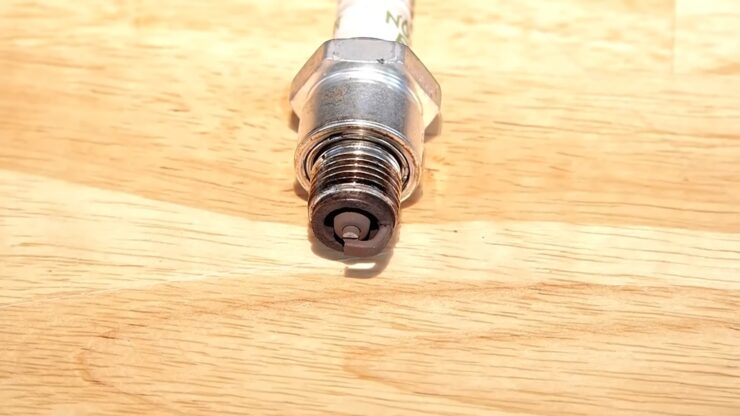
The outboard motor may sputter or lose power due to rusted or fouled spark plug wires. If you resolve this issue, you may notice that the performance of your engine returns to normal.
One by one, inspect each wire. Before removing the next wire, gently reinstall the one you have replaced after carefully inspecting it. The last thing you want to do is unplug all of the wires and then be confused about which one belongs where.
If you discover a clogged spark plug, your best bet is to replace it. Spark plugs are necessary but cheap. Regular replacement is a low-cost investment in high-performance outboard engines with a long engine line.
Alternatively, you can remove a fouled spark plug with a cloth in order to eliminate the majority of the accumulation. Scratch off any big portions of muck with sandpaper, a knife, or something similar. However, proceed with caution because you do not wish to harm the spark plug.
Bad Fuel
A fairly common reason for low RPM is bad fuel.
In the US, gasoline usually contains 10% ethanol. This is done to oxygenate the gasoline and allow it to burn completely. As a result, you are getting lower emissions and perhaps better efficiency.
However, ethanol also causes a whole bunch of problems down the line. Most importantly:
- Ethanol may become stale. With time, stale gasoline becomes less volatile, which makes it more difficult to ignite. This is actually the easiest problem to solve – you either need to replace the fuel or just use up your old fuel and replace it with fresh gasoline.
- Ethanol draws moisture. Alcohol absorbs moisture from the air around it. Water and ethanol sink to the bottom of gasoline when their moisture content rises. The fuel won’t be able to burn completely as a result of this.
- Microbes are drawn to moisture. Gasoline with moisture in it may encourage the growth of bacteria and germs in your fuel tank. Bacteria may clog your engine if they are not handled for a long time.
- Moisture causes rusting. Your gas tank may also rust from exposure to moisture. And although rust may not directly impact your RPM, it is a serious problem that needs to be promptly treated.
To troubleshoot fuel issues, you should use up or drain your fuel and have a look at the tank. If the tank seems fine, then just refill it.
If you see any mold, rust, or gunk inside your fuel tank, then you may attempt to clean it. In the worst case, if you don’t manage to remove the dirt, you will need to replace the tank.
Once you’re hopefully done fixing your tank, make sure to maintain it. Prevention is your best solution.
To avoid water contamination, you should keep your tanks full. This will minimize the amount of air inside.
Poor Cylinder Compression
If your outboard motor is not generating enough power, it could be due to a variety of issues such as leaky rings, worn-out cylinders, or faulty valves. When the cylinders fail to deliver the necessary pressure, they cannot compress the fuel efficiency to produce energy.
To diagnose problems with compression, a compression check should be performed. However, this should only be done by a professional with the right tools, as it can be dangerous if attempted by someone without experience.
For modern two-stroke outboard engines, a compression reading of at least 90 psi is recommended. If the readings are more than 10 psi apart, it could indicate issues with the rings or valves. If the readings are consistently low or inconsistent, a mechanic should be consulted to inspect the cylinders and provide guidance on the next steps.
Damaged or Dirty Carburetor
The purpose of a carburetor is to mix air with fuel for combustion. Needless to say, the condition of your carburetor is directly connected with the performance of your boat engine.
Among the telltale signs of a dirty or damaged carburetor are:
- w engine start.
- Poor idling quality.
- The slow transition from idle to mid-range RPM.
- Cylinders misfiring.
- You see no fuel when removing the drain screw from the bottom of the carburetor.
Depending on the condition of your carburetor, you may need to do the following:
- Run a carburetor cleaner through the carb. In less severe cases, this will solve the issue. Get yourself something like the Berryman B-12 cleaner and follow the instructions on the container to get your carb cleaned.
- Disassemble the carburetor and clean it.
- If you find out that your carburetor is defective during cleaning, then you will have to replace it.
Bad Neutral Safety Switch
Another potential reason for your boat acting strangely after working normally for a while is a faulty neutral safety switch. Depending on the model of your engine, you might find it inside the motor.
In some cases, disconnecting the neutral safety switch will solve the problem. Here’s a video demonstrating how to do this on a Mercury outboard.
Possible Causes of Your Boat’s Failure to Exceed 2000 RPM Under Load
It is a common question what rpm your outboard motor should run? If your boat engine won’t rev above 2000 RPM, it could be for a variety of reasons. That being stated, you are most likely dealing with one of the following:
- You can have a prop that isn’t right for your boat.
- There could be debris on or near the propeller.
- Your prop assembly can suffer damage.
- It’s possible that the neutral safety switch is broken.
- Your fuel could be in poor condition.
- Your compression ratio may be too poor.
- Your carburetor could be faulty or unclean.
- The engine on the boat could be overheating.
- Your ignition system could have failed.
If nothing else works, you should take your boat to a mechanic. If you have the insufficient technical know-how, you should also seek professional assistance; if you attempt to troubleshoot your boat on your own without any training, you risk missing significant facts or making matters worse.
FAQs
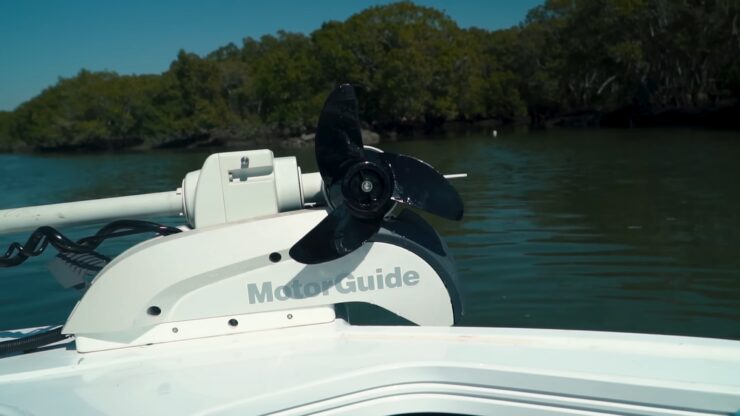
When a watercraft Cavitates, what happens?
Cavitation is a term used to describe the formation of underwater gas bubbles caused by a rapid propeller in low-pressure settings. Water can “boil” in a vacuum at specific low pressures and low temperatures, producing the bubbles we observe with faster propellers.
What is the distinction between a three-blade and a four-blade boat propeller?
The three-blade prop is faster than the four-blade prop because it has a smaller blade ratio. It is known for its faster top speed. Furthermore, the 4-blade (higher blade ratio) has a larger hole.
How does cavitation feel?
In a lipo cavitation session, the ultrasound machine may seem like a relaxing massage. Even though some people experience tingling or sensitivity, the procedure is completely painless and safe. Underlying tissues, cells, and organs are unaffected.
How Many RPMs Should a Boat Run at?
The number of RPMs a boat should run at varies depending on the type and size of the boat, as well as the engine and propeller. Generally, for outboard motors, the maximum recommended RPM range is specified by the manufacturer and can be found in the owner’s manual or on the motor itself.
It’s important to operate within this range to ensure optimal performance and prevent damage to the engine. For inboard engines, the recommended RPM range may also be specified by the manufacturer or determined by a technician based on the specific engine and boat.
Is it Bad to Run an Outboard Engine at Full Throttle?
Running an outboard engine at full throttle for extended periods of time can cause excessive wear and tear on the engine components, resulting in a shorter lifespan of the engine. It can also increase fuel consumption and potentially damage the propeller or other parts of the boat.
It’s important to follow the manufacturer’s recommendations for the maximum RPMs and to vary the engine speed during use to avoid running at full throttle for extended periods.
Conclusion
While our tips can be useful for most boat owners, it’s important to note that every situation is unique and a one-size-fits-all solution may not exist. Boat engines are complex machines, and there could be a multitude of issues at play.
If the suggested solutions don’t work, it’s best to take your boat to a professional mechanic. Even for those with some technical knowledge, attempting to troubleshoot the issue alone can be risky and may lead to further damage.
As a last resort, if your boat still won’t go over 3000 RPM under load despite all efforts, replacing the motor may be necessary. Be prepared for this possibility.
I’m Liam Jackson, the proud owner and driving force behind KayakPaddling.net. Born somewhere in the expansive beauty of the United States, I’ve nurtured a lifelong passion for kayaking and fishing that has led me to explore the far corners of our nation’s waterways.
Related Posts:
- Boat Tachometer Not Working - 4 Reasons & Solutions
- Exceeding Max HP Rating on Boat: All You Need to Know!
- 5 Best Sound Deadening Material for Boat Engine 2024…
- Livingston Boat Modifications: Things You Can Add
- How To Reduce Prop Slip? - Here’s How To Do It
- 11 Best Marine Carburetor for Your Boat 2024 -…

